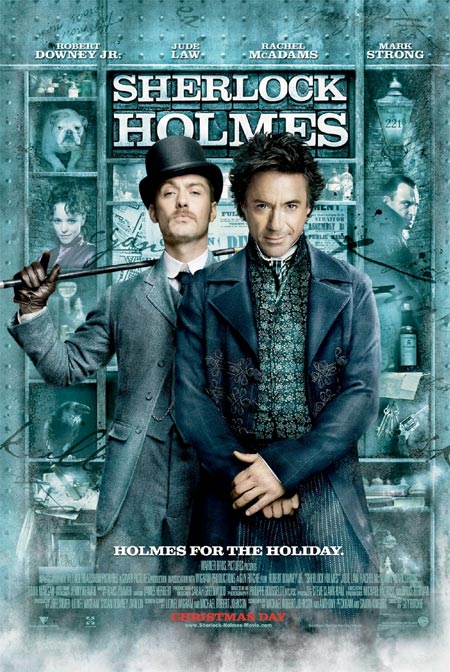Status: In theaters (opened 12/25/09)
Directed By: Guy Ritchie
Written By: Michael Robert Johnson and Anthony Peckham and Simon Kinberg
Cinematographer: Philippe Rousselot
Starring: Robert Downey Jr., Jude Law, Rachel McAdams, Mark Strong
Pre-Sold Franchises—that’s what Hollywood execs call a movie that’s based on an existing property. The thinking goes that by securing the rights to an already well-known setting with familiar characters, they can be virtually guaranteed a certain number of butts in the seats. Sequels, remakes, reboots, and adaptations all fit into this category, and are generally considered a safe investment of production dollars. Sherlock Holmes is Guy Ritchie’s chance to tackle a pre-sold franchise, offering him the opportunity to bring 100-plus-year-old characters to new life with his frenetic filmmaking style. It’s sort of a period version of Snatch., but the results are a thoroughly enjoyable film with surprisingly broad appeal.
The take on Holmes (Robert Downey Jr.) by Ritchie and his screenwriters is one that assumes we’re already familiar with the character and his ever-present sidekick Dr. Watson (Jude Law), and enjoys playing with that fact. We don’t get the ever-present pipe, but we do see it on infrequent occasions. Ditto for the trademark hat, toned down here and joked about via direct reference in the introductory scene, as if the screenplay is saying, “Okay, let’s just acknowledge this up front so that the cliches don’t get in the way of the fun we’re about to have.” And so it goes. The plot involves an evil master of the occult named Lord Blackwood (Mark Strong) who plans to take over late-19th-century London, and Holmes’ attempt to stop him and bring him to justice. Along the way, the detective’s long-lost love (Rachel McAdams) shows up and becomes involved in the story as well. It’s a classic-style detective tale, one that’s believably rooted in the 1800s and yet somehow still lets you know that it knows that you’re watching it in the 2000s.
Ritchie’s stylistic flair is present here, though it’s more toned down than in some of his previous films, presumably to lower the barrier to entry and capture the attention of all of those pre-sold audience members. He allows for a couple of storytelling devices that embellish the straightforward storyline in creative ways, the most prominent and most enjoyable being his onscreen depiction of Holmes’ analytic mind. Just as the action gets going, we see it in slow motion, as Holmes imagines things playing out while planning his moves and thinking the sequence through in his characteristic level of detail. We then go back to the start and see things occur in realtime, witnessing the fruits of Holmes’ mental labor as the set piece unfolds. This is slightly confusing the first time it’s used, but by the film’s climax Ritchie has done an effective job of acclimating the audience to the technique, and it serves to pull you into the action in an impressively sympathetic manner; we not only root for Holmes, we follow his train of thought in intimate detail and get to feel like we’re in on his rapid-fire planning as well.
Downey’s Sherlock is about what you’d expect: humorously self-deprecating and yet cocky at the same time. He’s professionally insecure, though he’d never admit it, and his demeanor with women is likewise more outwardly self-assured than his track record would indicate. Law plays Watson as the stick-in-the-mud realist who can’t help but get caught up in his associate’s adventure. They’re counter-pointed by the larger-than-life Blackwood, who is of a singular mindset and a singular evilness, though Strong’s depiction avoids going too over the top. And Rachel McAdams makes for a good damsel with an agenda of her own—we’d expect no less from a twisty-turny mystery.
Though the cast is great, and it’s hard to imagine Robert Downey ever taking a back seat, the real star of Sherlock Holmes might be its set design and special effects. Although some of the dialogue and details of the plot have a bit of a winkingly anachronistic bent, the world in which the film is set is an incredible recreation of 1891 London. Most impressive is London’s Tower Bridge, still under construction, which looms in the backgrounds and provides a constant presence before serving as the setting for the film’s climactic showdown. There’s also an incredible scene in a massive ship factory, with seamless CG effects that are on par with anything Avatar has to offer. The ship, and what happens to it, reminded me also of a scene involving a plane in the first act of Knowing, another film from 2009 that had effects so good they seem to have been overlooked.
You know what you’re getting going into Sherlock Holmes, and you also know you’re in for a few surprises. The plot has twists and clever bits of detective work, as expected, but what we haven’t seen before is Holmes being involved in this particular brand of fun. Downey is almost snickering throughout the movie, and we are too because Ritchie lets us in on the joke. We know we’re watching a Sherlock Holmes movie, and we mostly know what that entails, but it’s the additional touches that give it a style of its own beyond the prerequisites. It’s a sit-back-and-enjoy movie, and enjoyable it is.





I’m so pleased to read a review of “Sherlock Holmes” from someone who enjoyed the movie as much as I did. I’m a long-time Holmes fan and so was anxious to see this film, though I hadn’t seen any of Downey, Law or Richie’s previous work. It was just as entertaining, exciting, and fun as I thought it would be from the trailers I saw. Just one thing, though — that’s Tower Bridge under construction in the movie, not London Bridge. Other than that, great job!
Thanks for the correction. I’ve updated the post to reflect it.